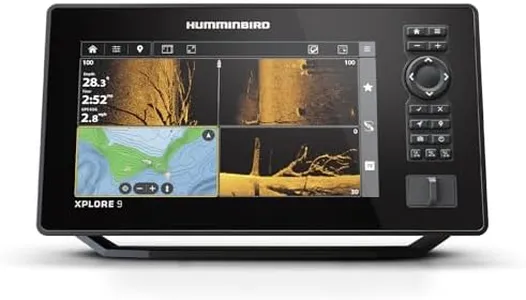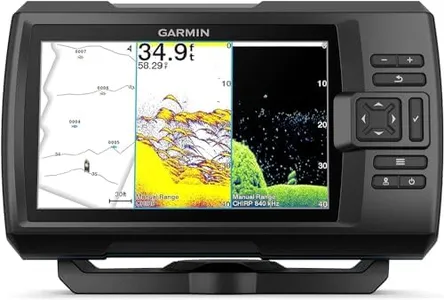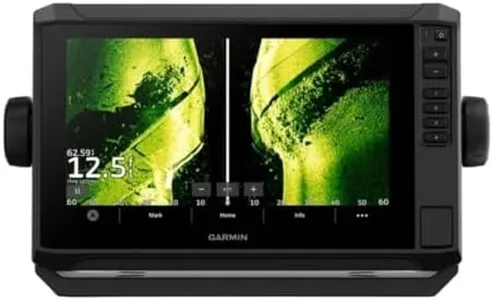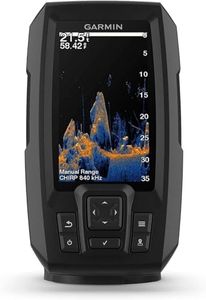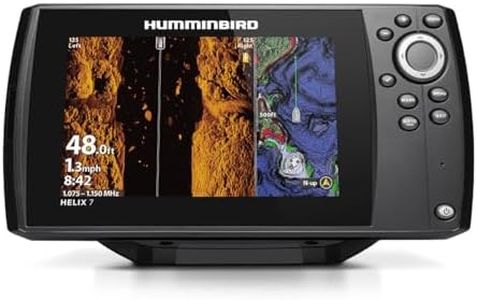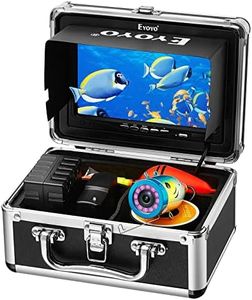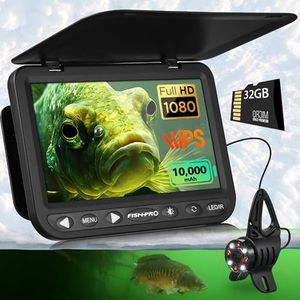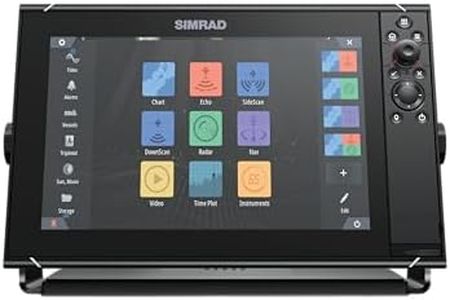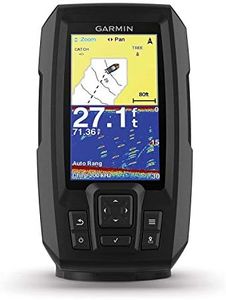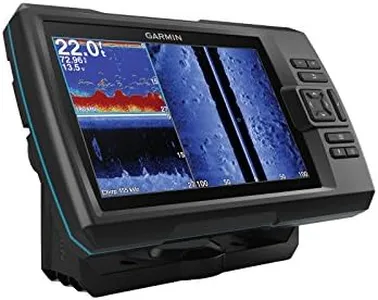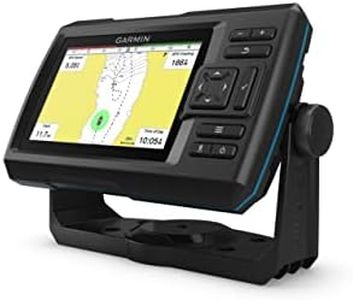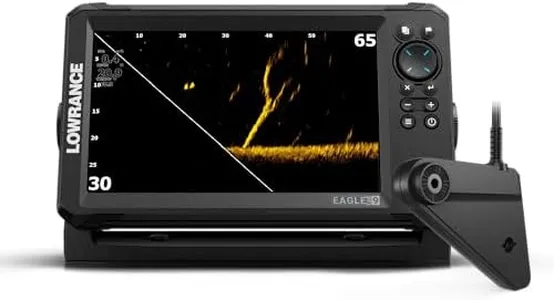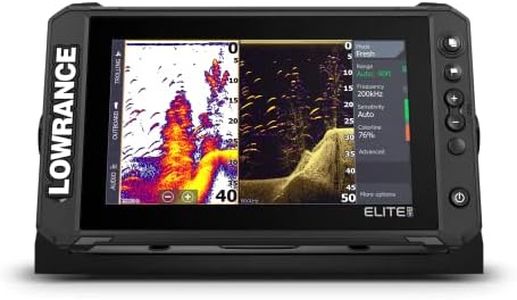10 Best Depth Finders 2025 in the United States
Our technology thoroughly searches through the online shopping world, reviewing hundreds of sites. We then process and analyze this information, updating in real-time to bring you the latest top-rated products. This way, you always get the best and most current options available.

Our Top Picks
Winner
Humminbird XPLORE 9 GPS Fish Finder with Transducer, MEGA Side Imaging+ & HD Touchscreen Display
The Humminbird XPLORE 9 GPS Fish Finder with Transducer is packed with advanced features suitable for serious anglers. It offers premium sonar technology with MEGA Side Imaging+ and Down Imaging+, giving clear views of fish up to 200 feet on each side and below your boat. The Dual Spectrum CHIRP allows for detailed fish detection in both wide and narrow modes. The built-in GPS with Humminbird Basemap and included LakeMaster and CoastMaster VX map card provide extensive coverage of over 10,000 lakes in the US and Canada, enhancing navigation and fishing accuracy.
Its AutoChart Live feature creates real-time maps of depth contours, bottom hardness, and vegetation, which is highly useful for mapping your favorite fishing spots. The display is a noteworthy strength, featuring a 9-inch Full HD touchscreen with a resolution of 1280 x 720, ensuring clarity and ease of use. Additionally, it includes dual control options for versatility in operation.
Connectivity is robust with high-speed Ethernet and Bluetooth, and it integrates seamlessly with Minn Kota and Cannon products, enhancing its functionality in a One-Boat Network setup. On the downside, the unit weighs 9 pounds, which might be a bit heavy for those seeking more portable options. However, for stationary or mounted use, this shouldn't be a significant issue. It comes with essential components like the control head, power adapter, unit cover, mounting bracket, and transducer, making it ready for immediate use. With a two-year warranty, users can feel secure about its durability and service. This fish finder is ideal for dedicated anglers looking for top-tier technology and comprehensive mapping capabilities.
Garmin Striker Vivid 7cv, U.S. with GT20-TM Transducer - Easy-to-Use 7-inch Color Fishfinder and Sonar Transducer, Vivid Scanning Sonar Color Palettes (010-02552-00)
Most important from
323 reviews
The Garmin Striker Vivid 7cv is a user-friendly 7-inch color fishfinder ideal for both amateur and experienced anglers. It comes with a GT20-TM transducer that supports both Garmin CHIRP traditional sonar and CHIRP ClearVü scanning sonar, which helps in clearly identifying fish and structures underwater. The vivid scanning sonar color palettes further enhance visualization, making it easier to distinguish between different underwater elements.
The display is an LCD screen, providing clear and bright visuals, which are essential during fishing trips in various lighting conditions. The high-sensitivity GPS is a noteworthy feature, allowing users to mark waypoints, create routes, and monitor their boat speed, adding a layer of navigational convenience. Additionally, the built-in Quickdraw Contours mapping is beneficial for creating custom fishing maps on the spot. Another modern touch is the Wi-Fi connectivity, enabling connection to the ActiveCaptain app for software updates and waypoint transfers, making it a tech-savvy choice.
However, the device is battery-powered, which might be a drawback for extended fishing trips unless spare batteries are carried. The unit is somewhat portable with a 4.4-pound weight and dimensions of 3.4"L x 6.1"W x 7"H, although it may not be the lightest option available. The surface mount installation could be a bit tricky for beginners but is manageable. The Garmin Striker Vivid 7cv stands out with its comprehensive sonar capabilities and smart features, making it a valuable tool for both casual and serious fishing enthusiasts.
Most important from
323 reviews
Garmin ECHOMAP UHD2 94sv with GT56 Transducer, 9" Touchscreen Chartplotter, Garmin Navionics+ U.S. Coastal
Most important from
145 reviews
The Garmin ECHOMAP UHD2 94sv depth-finder is designed with a focus on ease of use and comprehensive functionality for boating and fishing enthusiasts. The product features a 9-inch bright touchscreen display that ensures clear visibility even in direct sunlight, which is a crucial factor when navigating on water. The display size and resolution of 1024 x 600 provide adequate detail for chart plotting, although some users may prefer a higher resolution for more detailed images.
One of its standout features is the GT56-TM transducer which supports Garmin's traditional sonar as well as ClearVü and SideVü scanning sonars. This offers a wide range of scanning capabilities useful for detecting fish and underwater structures. The inclusion of CHIRP technology enhances target separation and provides clear images, making it well-suited for serious anglers.
The built-in Garmin Navionics+ coastal charts with integrated Navionics data offer comprehensive navigation support, which would be particularly beneficial for those fishing or boating along U.S. coastal areas. The unit's built-in Wi-Fi connectivity allows for seamless sharing of sonar data and navigation routes with other ECHOMAP UHD2 devices, which facilitates collaborative fishing trips or group navigation. Another notable feature is its wireless connectivity with Garmin’s Force trolling motor, allowing for advanced control such as creating routes and adjusting speed directly from the chartplotter, which can enhance the fishing experience.
While weighing 8.08 pounds, the device might be less portable compared to smaller units, but its mounting options (dashboard or panel) can accommodate different types of watercraft. Considering its features, the Garmin ECHOMAP UHD2 94sv depth-finder is an excellent choice for those who prioritize comprehensive sonar capabilities and detailed navigation, especially in coastal areas.
Most important from
145 reviews
Buying Guide for the Best Depth Finders
Choosing the right depth-finder can significantly enhance your fishing or boating experience. A depth-finder, also known as a fish finder or sonar, helps you determine the depth of the water and locate fish. To make an informed decision, you need to understand the key specifications and how they align with your specific needs. Here are the essential specs to consider when selecting a depth-finder.FAQ
Most Popular Categories Right Now
